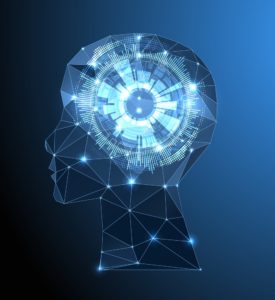Artificial Intelligence in Healthcare: AI moves from sci-fi movie plots to real world applications for coding, patient care and health management and strategy.
Artificial Intelligence (AI) is ‘machine learning’ and the ability to perform tasks without human direction.  Cognitive tasks include speech and visual interpretation, decision-making, problem-solving and complex data aggregation.
Cognitive tasks include speech and visual interpretation, decision-making, problem-solving and complex data aggregation.
AI may seem like a far-fetched sci-fi concept but it is already infused throughout our daily life. It is seen in Google Maps and its ability to reroute when traffic is up ahead, banking systems picking up on odd spending behavior and posting fraud alerts, personal assistants like Siri, Cortana and Alexa telling us where the nearest gas station is and smart home appliances that preemptively dim lights or turn on electronics based on our work schedule and lifestyle habits. The Amazons, Ubers and Googles of the world are trying to ship us goods before we run out of them (and before we even order them) and sell us cars that drive for us.
Artificial Intelligence in healthcare will become common place within non-clinical job functions. There are numerous advances already underway in the clinical care setting such as treatment plans individualized down to the genomic sequence of a patient, ability to develop oncology treatment plans in record time and virtual primary and urgent care based on image recognition.
Patients will also reap the benefits of AI outside of acute care including urgent care kiosks, medication management, and wellness and lifestyle coaching. Drug companies are also using AI to dramatically cut the drug discovery life cycle. Years of identifying drug to disease process links will be left to algorithms.
There will also be considerable gains and opportunities on the administrative and support staff side. We have already seen small advances in AI with the use of computer assisted coding (CAC). The main features of AI include learning problem-solving and decision-making skills, mining through extraordinarily large amounts of data, and recognizing patterns and making decisions based on those patterns. These capabilities will dramatically change coding, clinical documentation and queries, patient status determinations, staff ratios and value-based measures. As with CAC, however, AI will be most effective when paired with expert coders, clinicians and other subject matter experts. Extrapolating from its uses in other industries, there has been some speculation and predictions as to how AI can supplement revenue cycle and management tasks. Some of these ideas include:
- Coding – AI will not only learn how to code but will also be able to identify patterns in laboratory values and physician patterns in the procedures they perform while taking into account federal and state coding guidelines. Alternatively, AI could potentially serve as an educational tool, mining data from coders, and quickly identifying errors and patterns for on-the-spot educational opportunities.
- Clinical Documentation and Queries – Looking beyond CAC, AI will be support clinical documentation functions such as detecting patterns in physician documentation habits and proactively reaching out to providers for clarification. Furthermore, AI will be able to sift through coding and documentation guidelines and the pertinent patient data to suggest the most appropriate answers for the physician.
- Staffing ratios – AI will be able to mine admissions data, reasons for ER/clinic visits and other data that can inform both clinical and non-clinical department leaders on how to staff their departments. HIM departments will utilize the information to monitor its need for contractors and clinical leaders will determine the best mix of mid-level providers to physicians.
As with any technology, the value of articial intelligence in healthcare will be directly tied to engagement, adoption and correct application use. Most importantly, AI will only be as good as the data and inputs it uses. As in the case of Google Maps, AI uses special information gathered from maps. AI in clinical documentation and coding will use human inputs, or more specifically clinician documentation. The decisions and self-learning executed by AI will be directly tied to the accuracy and robustness of the clinical documentation. Furthermore, areas of gray will remain and require human intervention, such as in the case of ICD-10 procedure coding and other vague coding guildelines. Benefits to the healthcare industry will be amplified if hospitals and health systems (both small and large) have affordable access to the technology. As we’ve seen with other innovations, small hospitals will suffer if they cannot provide the same quality and level of care as other more profitable hospitals. It would be remiss to not touch upon the impact AI will have on every day administrative job functions. While we do not know how quickly AI will be adopted, we do know that a shift in skill set will eventually occur to monitor and audit the large amounts of analysis and decisions yielded by AI. We also anticipate a learning curve for both AI and a shift to exploring how such functions can work in gray areas
Full AI adoption into everyday healthcare activities will not happen overnight and until then we recommend that healthcare leaders continue to optimize the way they identify, monitor and act upon trends and patterns within their departments. Provident will continue to monitor the advances in AI to fully understand its application and benefits to healthcare processes, workflows and applications.
For more information on Provident’s clinical documentation and coding services please visit www.providentedge.com.
